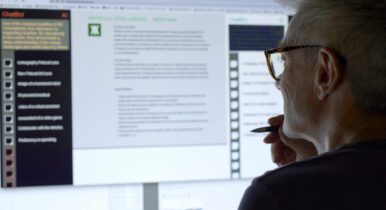Why Political Design Is Embracing ‘Heritage And History’
In this interview, one political design expert breaks down political branding trends and how designers can work with non-design campaign staff.
Ashleigh Axios grew up wanting to be an artist, although it wasn’t until a work-shadowing trip with a family member in the advertising industry that she saw the career potential for her passion. She went to art school at the Rhode Island School of Design (RISD), but felt drawn to social causes more than using design and psychology to influence product purchases.
That interest led her into the nonprofit world and then the Obama White House, where she began as the art director in 2012. Later, she became the creative director working out of the Office of Digital Strategy.
Today, she still works in the political and civic arena through her digital services agency Coforma. She also actively lends her expertise to AIGA, the professional association for design, as the chair of the Board of Directors and to the Digital Service Coalition.
C&E asked Axios about trends she’s watching, what makes good political design, how to handle lawyers governing your approvals process, diversity in the political design world, and what career advice she has for design professionals.
Q: What are the trends you’re watching in campaigns?
Axios: Campaign design is starting to flex to a point where folks are able to move away from red, white, and blue. Recently we saw Kamala Harris’s brand paying homage to Shirley Chisholm’s historic run in 1972 as the first African-American woman presidential candidate in U.S. history. Overall, there’s a more frequent embrace of and reference to heritage and history through visual language, narrative, and community building. We’re also seeing designers finally having fun in the space. This comes through in AOC’s stripey campaign design. It also comes through with the thoughtful gradient play that the Biden campaign was able to apply through Robyn Kanner’s guidance.
Q: What makes good political design?
Axios: I think the best designs have a good story behind them that directly connects with the candidates or the subject of the policy. When it’s done really authentically and thoughtfully, this type of design adds clarity and draws in the people who care about that topic, candidate, or community. The more unique, the better. I think it’s tempting for designers to work with the current trends, but doing so runs the risk of producing highly dated — as opposed to timeless — designs as well as blending the subject into the competition and noisy landscape of physical and online spaces. That’s not great. Those are the places a campaign wants a candidate or the subject to stand out. So instead, it’s about finding that differentiator for the candidate — what is their unique story in this space? And then bringing that out through the multifaceted design in clear, accessible ways. That is what really resonates and works.
Q: What’s the best way to handle non-design professionals who are part of an approvals process?
Axios: It took me a little while to learn some strategies and tactics. In the White House, I would come up against a lawyer who would just say no to proposals we brought before them. It was really hard to take back a no. After that I started to communicate why I was proposing something, what I was hoping to achieve and asking them what they would recommend so they could be part of the problem solving. That made a huge difference in our relationship and the results. I was able to work really collaboratively with lawyers, policymakers, and others to find creative, legal, effective, and sound ways of meeting our collective goals.
I also have had to let go of my pride to be effective. I recommend that others do the same. For example, when talking to a brilliant economist or a political advisor and they’re explaining something complex, it’s always been tempting for me to nod along even when I don’t completely understand what they’re saying because I know I can look it up afterwards.
The problem is that when I’m looking it up, I’m relying on another party as the translator, not building trust in the working relationship before me, and losing the opportunity to ask follow-up questions. So against my own initial instincts and fear or insecurities, I opt for vulnerability and ask questions. In fact, I sometimes ask them to explain it three different ways — talking it out or even drawing it out — so I get as much context to make it as clear as possible to myself and the end audience. Embrace being a little bit dumb. Nobody expects you to know everything.
Q: Is there enough diversity in the political design world?
Axios: Trick question? I don’t know if we could hit enough. There certainly is a lot of room for improvement today in the design field at large and in politics at large. The world is continually changing and so our goals should change and expand to (increasingly better) match these shifts.I also want to do my part to bust the pervasive myth that these areas — design and politics — aren’t diverse enough because there is a lack of interest, involvement, or candidates readily available for these roles and opportunities. While we need to invest in helping others enter and succeed in specific spaces like the political design world and there are a lot of efforts underway by communities, typically as a form of collective advocacy to do just that, that isn’t the singular challenge or an excuse.
Consider Maurice Cherry and his podcast, “Revision Path,” which is featuring hundreds of Black designers who are doing amazing work. That’s just one example of someone who is doing the work to lift up the talent that’s often claimed to be missing. There’s no limit of talent or skill in the existing community so long as our definition of the community is inclusive. What so many communities need is greater access to opportunities and more recognition, credit, and pay. Compared to spaces like tech today, there’s specifically a good amount of diversity within progressive political spaces and within higher-level design positions of government and politics. That’s also not saying a lot. More people need the opportunity to shine.
I was the first female, first person of color, youngest creative director for the White House. From that vantage point I can share that the fear one can have being in a position like that is you’re the first and perhaps the last. I feared being the token. I feared any individual fault or failure setting more than just myself back. There was a lot of pressure to do everything perfectly or as close as I could get to it. Disadvantaged communities often work twice as hard because they’re unfairly put in positions to present and demonstrate what can be with inclusion.
Disadvantaged community members in these scenarios also do loads of unpaid labor to advocate for the type of change that would make the hurdles they jumped through lessened for those who follow them. And ultimately, unfortunately, many of us aren’t in a position to control what people do with those recommendations and the precedents we set. For me, each day I hope to have helped open, or at bare minimum not inadvertently helped close, doors for others to come in, do better, and feel better due to an improved environment. I have that hope for the talented Carahna Magwood [the Biden White House creative director], and so many others.
Q: What’s your advice to designers looking to make their careers in politics?
Axios: Thankfully designers are now more aware of the possibility of working in political spaces. I would encourage those drawn to those arenas to think about trodding through the less worn down, less clear paths, because that’s often where the most need remains. I think a lot of designers are drawn to presidential campaigns now — as they should be, but I would urge them to also consider working with a local election for a candidate who they have a values alignment with, share community with, and who they can individually get to know. That’s going to build up their experience working with non-designers on important issues.



